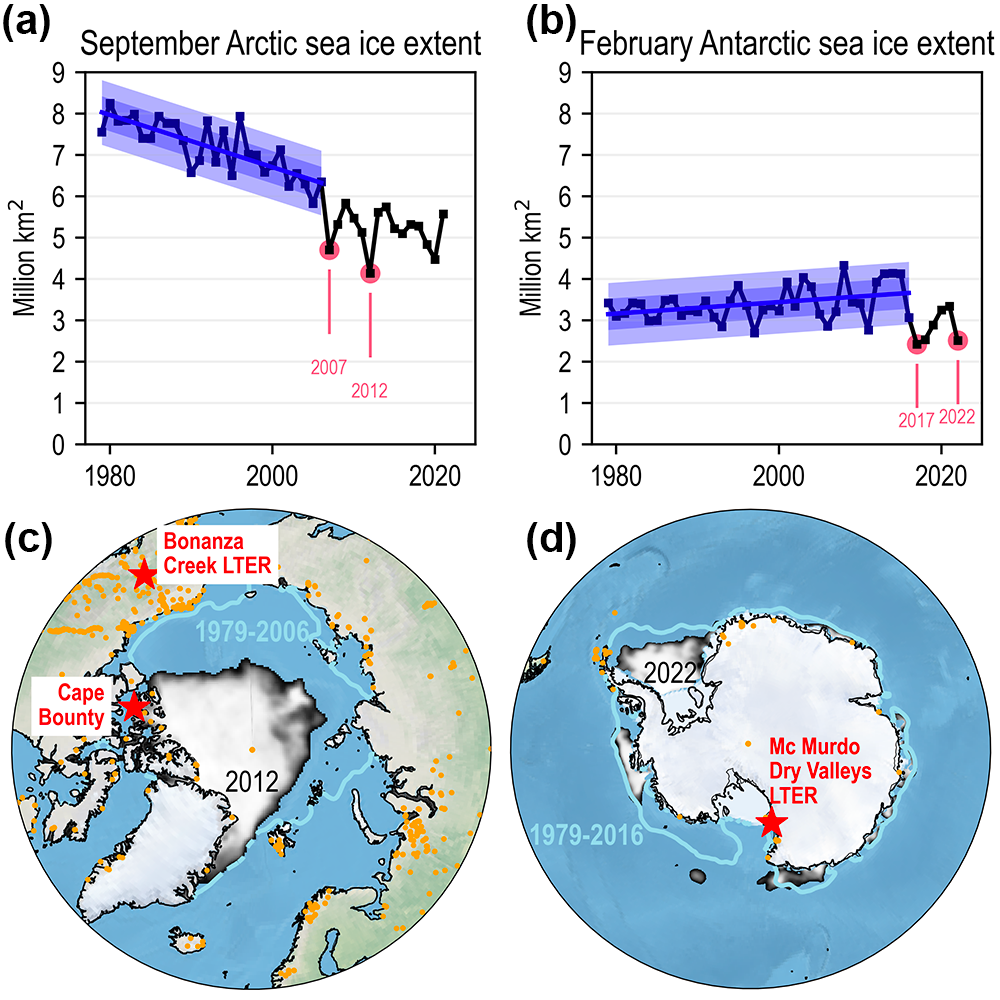Research
General context
Polar regions have experienced significant and disruptive changes in recent decades, partly due to the accumulation of greenhouse gases in the atmosphere. These changes include rising Arctic air temperatures surpassing the global average, reduced terrestrial snow cover, negative ice mass balance in Greenland and Antarctica, and increased heat transport to the Arctic Ocean. Antarctica, previously considered immune to climate change, is now showing signs of warming even in remote areas like the South Pole.
The evolution of sea ice has garnered much attention, as it serves as a critical indicator of high-latitude changes and presents both opportunities and risks for various stakeholders. The observed record of summer Arctic sea ice extent reveals intriguing features, with a rapid decline between 1979 and 2006, followed by record lows in 2007 and 2012. Studies attribute these records to factors such as long-term thinning of the ice, changes in atmospheric circulation, and increased poleward oceanic heat transport. Similarly, summer Antarctic sea ice variability has been puzzling, with a sudden drop in 2017 attributed to remote tropical forcings and changes in the large-scale atmospheric circulation.
The impacts of sea ice retreats on terrestrial ecosystems in the Arctic and Antarctic have been poorly investigated. The absence of summer sea ice near continents can induce anomalous surface warming, affecting the integrity of permafrost. Permafrost thaw releases previously frozen soil organic carbon, contributing to greenhouse gas emissions and positive feedback on global warming. Changing atmospheric conditions also influence growing seasons, leading to enhanced Arctic greening and feedbacks on permafrost integrity.
Modeling studies suggest that rapid Arctic sea ice loss events will cause significant land warming and permafrost degradation. However, there is a lack of specific studies on the atmospheric response to sea ice lows in the Antarctic.
Research objectives
The overarching aim of RESIST is to document, qualitatively and quantitatively, the cause-effect relationships between summer sea ice lows in both polar regions and their potential interacting agents (drivers and impacts). Sea ice lows are defined as events during which the September (February) Arctic (Antarctic) sea ice extent departs significantly from the long-term trend and presents a significant change compared to the previous year. The years 2007 and 2012 for the Arctic, and 2017 and 2022 for the Antarctic, correspond to such a definition.

To achieve this overarching aim, four specific research objectives have been defined:
(O1): Identify similarities and differences between the Arctic and Antarctic in terms of drivers and impacts of observed sea ice lows.
(O2): Quantify the added value of high spatial resolution in climate models to study cause-effect relationships between sea ice lows and their interacting agents.
(O3): Measure the inter-model dependence of mechanisms leading to sea ice lows.
(O4): Robustly sample the set of climate states that are compatible with sea ice lows.
Scientific novelty and positioning of the project
Sea ice lows and their impacts are inherently difficult to study, because there is only a limited number of such events in the observational record, but also because the causes explaining these lows are, like many climate extremes, multi-factorial. A quantitative understanding of the relative contributions of physical drivers on the recent but also future sea ice lows requires (1) state-of-the-art modeling tools capturing the range of sea ice-ocean-atmosphere interactions on all scales and (2) robust statistics to place the events in their climate context.
The emergence of new modeling tools (coupled General Circulation and Earth System Models, eddy-resolving global ocean—sea ice models, large ensembles), of new types of model experiments (e.g., dynamical nudging, dynamical ensemble sub-selection), and of data analysis approaches (e.g., causal inference frameworks) is profoundly reshaping our ability to analyze and interpret climate extremes. RESIST ambitions to apply these latest state-of-the art techniques to shed new light on the mechanisms that control exceptional melt rates of sea ice at the seasonal time scale, and how these mechanisms might differ from one hemisphere to the other. Such an intercomparison has never been attempted before.